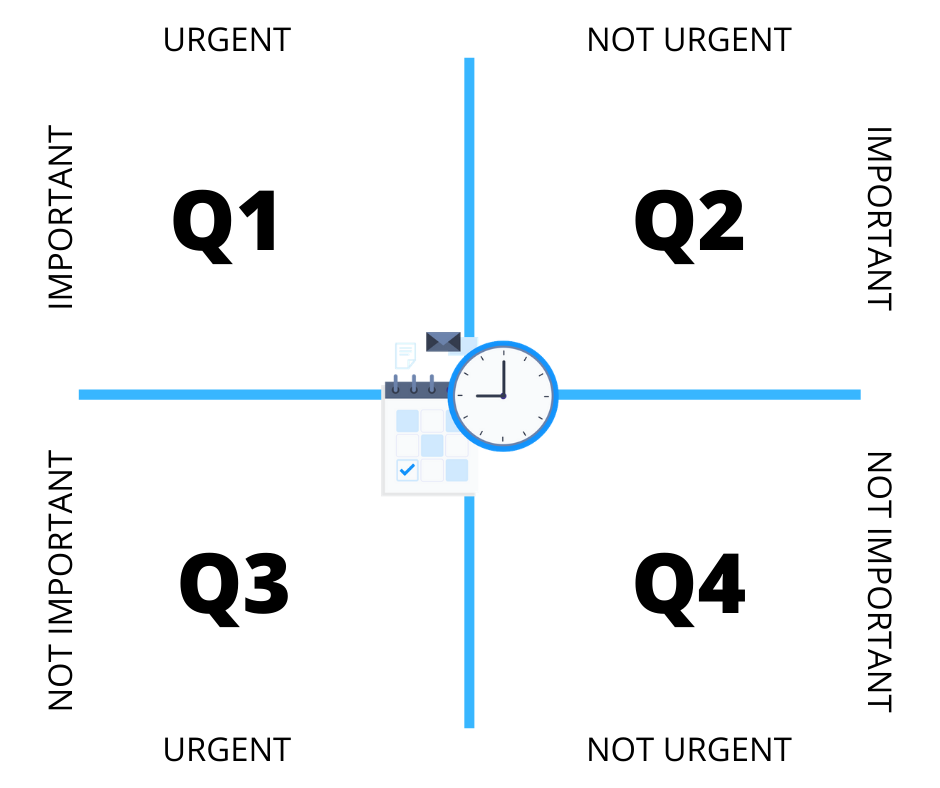14 Best Social Media Automation Tools To Leverage in 2023
We know the struggles of social media managers: juggling multiple accounts, keeping up with content creation, and never quite having enough hours in the day. 🥵 Well, we’ve got your...

If you work in marketing, chances are that you usually have far more than one task to accomplish at a time. Some of your duties require a strategic approach and can’t be completed in a heartbeat. Others can take a few seconds, but ruin your productivity and focus for a day. Finding the golden mean between them and not being overloaded by tasks therefore comes across as a challenge.
How to be more productive? You may find the answer resides in the Eisenhower box. Today, we’re going to talk about this urgent-important matrix and how it can help you unleash your productivity.
The Eisenhower box, a type of prioritization framework that is often called an urgent-important matrix, is one of the most popular methods of organizing tasks. It’s believed to have been used and popularized by Dwight D. Eisenhower.
It’s based on four quadrants, the so-called “squares” in the box, that help group your tasks according to their importance and urgency, which are predefined by you. To do it in the most efficient way that works, you need to practice and learn how to sort your tasks out so that they land in the right Eisenhower square.
Before we take a closer look at the Eisenhower box, let’s answer one crucial question that can help you divide tasks correctly.
The terms “important” and “urgent” are often mistaken since they both refer to something that is “crucial”. It’s essential to understand the difference.
Urgent refers to a task that requires you to act now, immediately.
These tasks may not necessarily be extremely important for the overall strategy, but they need to be accomplished as soon as possible. Urgent tasks are those that are due soon if not already overdue, so they require quick reactions and they bring quick results (or consequences, if they are not delivered on time).
Important refers to a task that is crucial to the long-term strategy and for achieving a particular goal. Important tasks don’t usually have to be completed right away.
The man himself perhaps differentiates the two types of tasks best:
“I have two kinds of problems: the urgent and the important. The urgent are not important, and the important are never urgent.” — Eisenhower
A task can be both important and urgent at the same time, but usually it’s not.
To master Eisenhower’s method, you need to learn how to recognize and qualify your tasks. We’ll cover this later on.
The urgent-important matrix consists of four quadrants of tasks, each called an Eisenhower box or Eisenhower square.

This group includes tasks that need to be done now and in person.
They often include tasks related to crisis management, emergencies, deadlines or sudden unpredictable situations that need to be dealt with immediately.
Examples:
While there is no way to eliminate such tasks completely, some of them could have been prevented or prepared for in advance with the right Eisenhower square.
The second group consists of tasks that you need to decide whether to proceed with or leave them in the pipeline for now. Many marketers working with the Eisenhower box spend most of their time in this Eisenhower square.
This group includes tasks that can be scheduled for the future. While they are not urgent yet, they could become urgent at any time. It’s better to track what’s in this group regularly and not put tasks aside when there’s no need to, or when you have a free slot in your pipeline.
They often refer to planning, improvements or building relations. While assigning deadlines is not required here, it may help you to stay motivated.
Examples:
Completing tasks from this Eisenhower square may result in fewer stressful situations, give you more control over your projects and drive constant improvement.
By spending more time on Q2 tasks, you can eliminate unpredictable or unpleasant situations in Q1, balance out Q3 tasks and even enjoy some of the Q4 “time-wasters” that you might now get a chance for.
The third group consists of tasks that can be delegated or eliminated. Having a never-ending list of tasks in this category is a catastrophe for productivity, so you should try to avoid having a pile-up of duties here.
As we have already mentioned, Urgent doesn’t have to mean Important. Spending too much time on tasks in this category can result in a short-term vision and neglecting what really matters to your business. Whenever you can, try to delegate, reduce and get rid of tasks in this Eisenhower square.
Examples:
Don’t mistake Q3 with Q1 in the Eisenhower box: you may be unduly pleased about completing a lot of tasks on a daily basis. But Q3 (not important but urgent) tasks don’t contribute to your long-term goals anywhere near the extent that Q1 (important and urgent) tasks do.
How to be more productive to get your control and reputation back? Work on minimizing such tasks in your pipeline and learn how to say “no” to some of the requests that help others but distract you. It’s for your own good.
The fourth group includes a backlog of tasks, resources or ideas to be put in a timeframe for the future, but also distractive activities that have been mistakenly named as “tasks”. Many of them should be dropped at this stage before they make some mess in other quadrants – or completed only when they make business sense.
Examples:
Tracking ideas and moving them to a particular Eisenhower square when needed is crucial to have full control over this quadrant.

Dividing tasks into sections may be tricky. We live in an era where information clutter makes everything sound urgent and important.
Distinguishing between what’s urgent and what’s important is the very first step you should take.
Using an urgent-important matrix instead of linear to-do lists can help you focus on what’s really crucial for your strategy and work. To-do lists tend to be long and unstructured, whereas the Eisenhower box provides four clear groups of tasks to let you know how your pipeline looks like.
Do all tasks need to be completed? Yes, eventually. Even if you delegate, you may have to supervise and review them later. However, with smart task prioritization in an urgent-important matrix, you can get them done quicker and focus on the business core.
If you want to know how to be more productive, we’ve also listed a few helpful tactics that may help you complete your tasks.

Social media managers need to adopt new trends, changes and updates quickly. When there are many new tasks coming along, it’s not difficult to get lost. With the right task prioritization using the Eisenhower box, new duties will be seen as challenges and part of the process rather than as struggles.
Prioritizing tasks helps marketing specialists identify the most crucial tasks and focus on them when others are patiently waiting in the backlog. Having a lot on one plate may go hand-in-hand with resentment and frustration, but prioritization can sort this out and help you enjoy your work.
Mastering task prioritization doesn’t happen overnight, but you may see the difference really quickly once you’re on to it. By classifying your tasks and dividing them into quadrants you can be more productive, spend more time on planning or just less on panicking, and deliver an even higher quality of your work.
Task prioritization supports looking at tasks via a different perspective. Instead of putting processes like “working on improving our social media strategy” into the pipeline, you can break the process into parts.
Using the Eisenhower box eases the pain of a never-ending workload. This clear division of tasks shows you exactly what should be done, planned, delegated or eliminated. One long to-do list can be replaced by an urgent-important matrix, from which you’ll soon notice that it’s okay for some tasks to wait in the queue.
The world will still turn on its axis if you don’t complete them all today.
The sooner you recognize potential sources of disagreement and disappointment, the sooner you’re able to fix them.
Sometimes even such trivial things as endless email chains may lead to frustration and therefore disturb the creation of a solid team culture.
You can also use tools like TeamMood to quickly evaluate the “mood” of your team and identify problems or situations to solve, or run employee surveys to measure team satisfaction.
Working on social media can be really distracting. It’s hard to resist the temptation of checking your Facebook feed, opening Instagram from time to time or refreshing Twitter. Dividing tasks up can show you how much time you’re wasting on unproductive things and help you eliminate those that bring distraction.
Social media managers have a lot of tasks connected with strategy, analytics or distribution. Prioritizing them can save a lot of time, frustration and hassle. While there are many tasks that should be done now or in the near future, others can be delegated or removed from your Eisenhower box. If you’re looking for some ideas on how to be more productive, this one may just hit the jackpot for you.